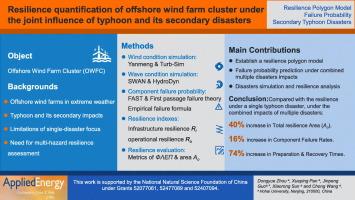Resilience quantification of offshore wind farm cluster under the joint influence of typhoon and its secondary disasters
IF 11
1区 工程技术
Q1 ENERGY & FUELS
引用次数: 0
Abstract
The rapid development of offshore wind power has significantly drawn attention to its operation dangers because of the frequent extreme weather events such as typhoons. Existing resilience evaluation for offshore wind farm cluster (OWFC) focuses more on the risks associated with a single typhoon disaster and less on the joint influence of multiple disasters, which may underestimate its vulnerability since a typhoon is prone to trigger secondary disasters, such as huge ocean waves and storm surges, which may cause severe damage to offshore wind turbines. We instead propose a new method to evaluate the resilience of OWFC under a typhoon and its secondary disasters. First, the typhoon and typhoon-induced ocean waves are numerically simulated according to the ocean environments. Considering the coupled effects of a typhoon and its secondary disasters on wind turbines and submarine cables, the failure rates of wind turbines and the collector networks are then calculated based on the structural response model and the first failure theory. Followed by this, a new polygonal model is proposed to quantify the resilience of offshore wind farms under the joint influence of the typhoon and its secondary disasters. Finally, the resilience of an actual OWFC is analyzed, and our resilience value is approximately 40 % lower than that under a single typhoon disaster, indicating its vulnerability to withstand multiple disasters and the necessity of considering typhoon-induced secondary disasters in the resilience assessment of OWFC. This study contributes to improving the operational safety and risk prevention levels of offshore wind energy.

台风及其次生灾害共同影响下海上风电场集群恢复力量化
由于台风等极端天气事件的频繁发生,海上风电的快速发展引起了人们对其运行危险性的极大关注。现有的海上风电场集群恢复力评估更多地关注单个台风灾害的风险,而较少关注多种灾害的联合影响,这可能低估了其脆弱性,因为台风容易引发二次灾害,如巨大的海浪和风暴潮,这些灾害可能对海上风力发电机造成严重破坏。我们提出了一种新的方法来评估台风及其次生灾害下OWFC的恢复能力。首先,根据海洋环境对台风及台风诱发的海浪进行了数值模拟。考虑台风及其次生灾害对风力发电机组和海底电缆的耦合作用,基于结构响应模型和首次失效理论计算风力发电机组和集热器网络的故障率。在此基础上,提出了一种新的多边形模型来量化台风及其次生灾害共同影响下海上风电场的恢复力。最后,分析了实际OWFC的恢复力,我们的恢复力值比单一台风灾害下的恢复力值低约40%,表明OWFC对多重灾害的脆弱性,以及在OWFC的恢复力评估中考虑台风次生灾害的必要性。该研究有助于提高海上风电的运行安全和风险防范水平。
本文章由计算机程序翻译,如有差异,请以英文原文为准。
求助全文
约1分钟内获得全文
求助全文
来源期刊

Applied Energy
工程技术-工程:化工
CiteScore
21.20
自引率
10.70%
发文量
1830
审稿时长
41 days
期刊介绍:
Applied Energy serves as a platform for sharing innovations, research, development, and demonstrations in energy conversion, conservation, and sustainable energy systems. The journal covers topics such as optimal energy resource use, environmental pollutant mitigation, and energy process analysis. It welcomes original papers, review articles, technical notes, and letters to the editor. Authors are encouraged to submit manuscripts that bridge the gap between research, development, and implementation. The journal addresses a wide spectrum of topics, including fossil and renewable energy technologies, energy economics, and environmental impacts. Applied Energy also explores modeling and forecasting, conservation strategies, and the social and economic implications of energy policies, including climate change mitigation. It is complemented by the open-access journal Advances in Applied Energy.
 求助内容:
求助内容: 应助结果提醒方式:
应助结果提醒方式:


